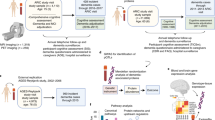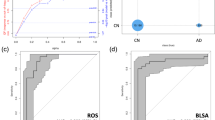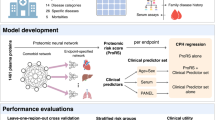Abstract
The advent of proteomics offers an unprecedented opportunity to predict dementia onset. We examined this in data from 52,645 adults without dementia in the UK Biobank, with 1,417 incident cases and a follow-up time of 14.1 years. Of 1,463 plasma proteins, GFAP, NEFL, GDF15 and LTBP2 consistently associated most with incident all-cause dementia (ACD), Alzheimer’s disease (AD) and vascular dementia (VaD), and ranked high in protein importance ordering. Combining GFAP (or GDF15) with demographics produced desirable predictions for ACD (area under the curve (AUC) = 0.891) and AD (AUC = 0.872) (or VaD (AUC = 0.912)). This was also true when predicting over 10-year ACD, AD and VaD. Individuals with higher GFAP levels were 2.32 times more likely to develop dementia. Notably, GFAP and LTBP2 were highly specific for dementia prediction. GFAP and NEFL began to change at least 10 years before dementia diagnosis. Our findings strongly highlight GFAP as an optimal biomarker for dementia prediction, even more than 10 years before the diagnosis, with implications for screening people at high risk for dementia and for early intervention.
This is a preview of subscription content, access via your institution
Access options
Access Nature and 54 other Nature Portfolio journals
Get Nature+, our best-value online-access subscription
$29.99 / 30 days
cancel any time
Subscribe to this journal
Receive 12 digital issues and online access to articles
$119.00 per year
only $9.92 per issue
Buy this article
- Purchase on Springer Link
- Instant access to full article PDF
Prices may be subject to local taxes which are calculated during checkout





Similar content being viewed by others

Data availability
The data used in the present study are available from UK Biobank with restrictions applied. Data were used under license and are thus not publicly available. Access to the UK Biobank data can be requested through a standard protocol (https://www.ukbiobank.ac.uk/register-apply/). Data used in this study are available in the UK Biobank under application number 19542. All data supporting the findings described in this manuscript are available in the article and in the supplementary materials and from the corresponding author upon request. Source data are provided with this paper.
Code availability
All software used in this study is publicly available. The code used in this study can be accessed at https://github.com/jasonHKU0907/DementiaProteomicPrediction.
References
Scheltens, P. et al. Alzheimer’s disease. Lancet 397, 1577–1590 (2021).
Swaddiwudhipong, N. et al. Pre-diagnostic cognitive and functional impairment in multiple sporadic neurodegenerative diseases. Alzheimers Dement. 19, 1752–1763 (2023).
Shah, H. et al. Research priorities to reduce the global burden of dementia by 2025. Lancet Neurol. 15, 1285–1294 (2016).
Teunissen, C. E. et al. Blood-based biomarkers for Alzheimer’s disease: towards clinical implementation. Lancet Neurol. 21, 66–77 (2022).
Zetterberg, H. Biofluid-based biomarkers for Alzheimer’s disease-related pathologies: an update and synthesis of the literature. Alzheimers Dement. 18, 1687–1693 (2022).
Hansson, O. et al. The Alzheimer’s Association appropriate use recommendations for blood biomarkers in Alzheimer’s disease. Alzheimers Dement. 18, 2669–2686 (2022).
Nakamura, A. et al. High performance plasma amyloid-beta biomarkers for Alzheimer’s disease. Nature 554, 249–254 (2018).
Palmqvist, S. et al. Prediction of future Alzheimer’s disease dementia using plasma phospho-tau combined with other accessible measures. Nat. Med. 27, 1034–1042 (2021).
Verberk, I. M. W. et al. Serum markers glial fibrillary acidic protein and neurofilament light for prognosis and monitoring in cognitively normal older people: a prospective memory clinic-based cohort study. Lancet Healthy Longev. 2, e87–e95 (2021).
Kim, K. et al. Clinically accurate diagnosis of Alzheimer’s disease via multiplexed sensing of core biomarkers in human plasma. Nat. Commun. 11, 119 (2020).
Ashton, N. J. et al. Differential roles of Aβ42/40, p-tau231 and p-tau217 for Alzheimer’s trial selection and disease monitoring. Nat. Med. 28, 2555–2562 (2022).
Karikari, T. K. et al. Blood phosphorylated tau 181 as a biomarker for Alzheimer’s disease: a diagnostic performance and prediction modelling study using data from four prospective cohorts. Lancet Neurol. 19, 422–433 (2020).
Mattsson-Carlgren, N. et al. Prediction of longitudinal cognitive decline in preclinical Alzheimer disease using plasma biomarkers. JAMA Neurol. 80, 360–369 (2023).
Karikari, T. K. et al. Blood phospho-tau in Alzheimer disease: analysis, interpretation, and clinical utility. Nat. Rev. Neurol. 18, 400–418 (2022).
Tanaka, T. et al. Plasma proteomic signatures predict dementia and cognitive impairment. Alzheimers Dement. (N Y) 6, e12018 (2020).
Hye, A. et al. Proteome-based plasma biomarkers for Alzheimer’s disease. Brain 129, 3042–3050 (2006).
Bai, B. et al. Proteomic landscape of Alzheimer’s disease: novel insights into pathogenesis and biomarker discovery. Mol. Neurodegener. 16, 55 (2021).
Walker, K. A. et al. Large-scale plasma proteomic analysis identifies proteins and pathways associated with dementia risk. Nat. Aging 1, 473–489 (2021).
Dubois, B. et al. Clinical diagnosis of Alzheimer’s disease: recommendations of the International Working Group. Lancet Neurol. 20, 484–496 (2021).
de Wolf, F. et al. Plasma tau, neurofilament light chain and amyloid-β levels and risk of dementia; a population-based cohort study. Brain 143, 1220–1232 (2020).
Ma, W. et al. Elevated levels of serum neurofilament light chain associated with cognitive impairment in vascular dementia. Dis. Markers 2020, 6612871 (2020).
Benedet, A. L. et al. Differences between plasma and cerebrospinal fluid glial fibrillary acidic protein levels across the Alzheimer disease continuum. JAMA Neurol. 78, 1471–1483 (2021).
Cicognola, C. et al. Plasma glial fibrillary acidic protein detects Alzheimer pathology and predicts future conversion to Alzheimer dementia in patients with mild cognitive impairment. Alzheimers Res. Ther. 13, 68 (2021).
McGrath, E. R. et al. Growth differentiation factor 15 and NT-proBNP as blood-based markers of vascular brain injury and dementia. J. Am. Heart Assoc. 9, e014659 (2020).
Whelan, C. D. et al. Multiplex proteomics identifies novel CSF and plasma biomarkers of early Alzheimer’s disease. Acta Neuropathol. Commun. 7, 169 (2019).
Dulewicz, M., Kulczyńska-Przybik, A., Słowik, A., Borawska, R. & Mroczko, B. Neurogranin and neuronal pentraxin receptor as synaptic dysfunction biomarkers in Alzheimer’s disease. J. Clin. Med. 10, 4575 (2021).
O’Connor, A. et al. Plasma GFAP in presymptomatic and symptomatic familial Alzheimer’s disease: a longitudinal cohort study. J. Neurol. Neurosurg. Psychiatry 94, 90–92 (2023).
Kuhle, J. et al. Serum neurofilament light chain is a biomarker of human spinal cord injury severity and outcome. J. Neurol. Neurosurg. Psychiatry 86, 273–279 (2015).
Fuchs, T. et al. Macrophage inhibitory cytokine-1 is associated with cognitive impairment and predicts cognitive decline – the Sydney Memory and Aging Study. Aging Cell 12, 882–889 (2013).
Babu, H. et al. Systemic inflammation and the increased risk of inflamm-aging and age-associated diseases in people living with HIV on long term suppressive antiretroviral therapy. Front. Immunol. 10, 1965 (2019).
Castellano, J. M. et al. Low-density lipoprotein receptor overexpression enhances the rate of brain-to-blood Aβ clearance in a mouse model of β-amyloidosis. Proc. Natl Acad. Sci. USA 109, 15502–15507 (2012).
Li, W. et al. Dl-3-n-butylphthalide reduces cognitive impairment induced by chronic cerebral hypoperfusion through GDNF/GFRα1/Ret signaling preventing hippocampal neuron apoptosis. Front. Cell Neurosci. 13, 351 (2019).
Oeckl, P. et al. Serum GFAP differentiates Alzheimer’s disease from frontotemporal dementia and predicts MCI-to-dementia conversion. J. Neurol. Neurosurg. Psychiatry 93, 659–667 (2022).
Kivisäkk, P. et al. Plasma biomarkers for diagnosis of Alzheimer’s disease and prediction of cognitive decline in individuals with mild cognitive impairment. Front. Neurol. 14, 1069411 (2023).
Beyer, L. et al. Amyloid-beta misfolding and GFAP predict risk of clinical Alzheimer’s disease diagnosis within 17 years. Alzheimers Dement. 19, 1020–1028 (2023).
Stocker, H. et al. Association of plasma biomarkers, p-tau181, glial fibrillary acidic protein, and neurofilament light, with intermediate and long-term clinical Alzheimer’s disease risk: results from a prospective cohort followed over 17 years. Alzheimers Dement. 19, 25–35 (2023).
Oeckl, P. et al. Glial fibrillary acidic protein in serum is increased in Alzheimer’s disease and correlates with cognitive impairment. J. Alzheimers Dis. 67, 481–488 (2019).
Heller, C. et al. Plasma glial fibrillary acidic protein is raised in progranulin-associated frontotemporal dementia. J. Neurol. Neurosurg. Psychiatry 91, 263–270 (2020).
Verberk, I. M. W. et al. Combination of plasma amyloid beta(1-42/1-40) and glial fibrillary acidic protein strongly associates with cerebral amyloid pathology. Alzheimers Res. Ther. 12, 118 (2020).
Rajan, K. B. et al. Remote blood biomarkers of longitudinal cognitive outcomes in a population study. Ann. Neurol. 88, 1065–1076 (2020).
Katisko, K. et al. GFAP as a biomarker in frontotemporal dementia and primary psychiatric disorders: diagnostic and prognostic performance. J. Neurol. Neurosurg. Psychiatry 92, 1305–1312 (2021).
Katsanos, A. H. et al. Plasma glial fibrillary acidic protein in the differential diagnosis of intracerebral hemorrhage. Stroke 48, 2586–2588 (2017).
Undén, J. et al. Explorative investigation of biomarkers of brain damage and coagulation system activation in clinical stroke differentiation. J. Neurol. 256, 72–77 (2009).
Elahi, F. M. et al. Plasma biomarkers of astrocytic and neuronal dysfunction in early- and late-onset Alzheimer’s disease. Alzheimers Dement. 16, 681–695 (2020).
Shir, D. et al. Association of plasma glial fibrillary acidic protein (GFAP) with neuroimaging of Alzheimer’s disease and vascular pathology. Alzheimers Dement. (Amst.) 14, e12291 (2022).
Vermeer, S. E. et al. Silent brain infarcts and the risk of dementia and cognitive decline. N. Engl. J. Med. 348, 1215–1222 (2003).
Prins, N. D. & Scheltens, P. White matter hyperintensities, cognitive impairment and dementia: an update. Nat. Rev. Neurol. 11, 157–165 (2015).
Cullen, N. C. et al. Plasma biomarkers of Alzheimer’s disease improve prediction of cognitive decline in cognitively unimpaired elderly populations. Nat. Commun. 12, 3555 (2021).
Fyfe, I. Neurofilament light chain – new potential for prediction and prognosis. Nat. Rev. Neurol. 15, 557 (2019).
Pilotto, A. et al. Plasma neurofilament light chain predicts cognitive progression in prodromal and clinical dementia with Lewy bodies. J. Alzheimers Dis. 82, 913–919 (2021).
Gisslén, M. et al. Plasma concentration of the neurofilament light protein (NFL) is a biomarker of CNS injury in HIV infection: a cross-sectional study. EBioMedicine 3, 135–140 (2016).
Chai, Y. L. et al. Growth differentiation factor-15 and white matter hyperintensities in cognitive impairment and dementia. Medicine (Baltimore) 95, e4566 (2016).
Walker, K. A. et al. Proteomics analysis of plasma from middle-aged adults identifies protein markers of dementia risk in later life. Sci. Transl. Med. 15, eadf5681 (2023).
Schindowski, K. et al. Regulation of GDF-15, a distant TGF-β superfamily member, in a mouse model of cerebral ischemia. Cell Tissue Res. 343, 399–409 (2011).
Andersson, C. et al. Associations of circulating growth differentiation factor-15 and ST2 concentrations with subclinical vascular brain injury and incident stroke. Stroke 46, 2568–2575 (2015).
van Dijk, E. J. et al. Progression of cerebral small vessel disease in relation to risk factors and cognitive consequences: Rotterdam Scan study. Stroke 39, 2712–2719 (2008).
Conte, M. et al. GDF15, an emerging key player in human aging. Ageing Res. Rev. 75, 101569 (2022).
Wang, D. et al. GDF15: emerging biology and therapeutic applications for obesity and cardiometabolic disease. Nat. Rev. Endocrinol. 17, 592–607 (2021).
Marks, J. D. et al. Comparison of plasma neurofilament light and total tau as neurodegeneration markers: associations with cognitive and neuroimaging outcomes. Alzheimers Res. Ther. 13, 199 (2021).
Cousins, K. A. Q. et al. ATN incorporating cerebrospinal fluid neurofilament light chain detects frontotemporal lobar degeneration. Alzheimers Dement. 17, 822–830 (2021).
Illán-Gala, I. et al. Plasma tau and neurofilament light in frontotemporal lobar degeneration and Alzheimer disease. Neurology 96, e671–e683 (2021).
Jiang, Y. et al. Large-scale plasma proteomic profiling identifies a high-performance biomarker panel for Alzheimer’s disease screening and staging. Alzheimers Dement. 18, 88–102 (2022).
Prince, M. et al. World Alzheimer Report 2015—The Global Impact of Dementia: An Analysis of Prevalence, Incidence, Cost and Trends. Alzheimer’s Disease International www.alzint.org/resource/world-alzheimer-report-2015/ (2015).
You, J. et al. Development of a novel dementia risk prediction model in the general population: a large, longitudinal, population-based machine-learning study. EClinicalMedicine 53, 101665 (2022).
Sun, B. B. et al. Plasma proteomic associations with genetics and health in the UK Biobank. Nature 622, 329–338 (2023).
Dhindsa, R. S. et al. Rare variant associations with plasma protein levels in the UK Biobank. Nature 622, 339–347 (2023).
Wik, L. et al. Proximity extension assay in combination with next-generation sequencing for high-throughput proteome-wide analysis. Mol. Cell Proteomics 20, 100168 (2021).
Elliott, P., Peakman, T. C. & UK Biobank The UK Biobank sample handling and storage protocol for the collection, processing and archiving of human blood and urine. Int. J. Epidemiol. 37, 234–244 (2008).
You, J. et al. Plasma proteomic profiles predict individual future health risk. Nat. Commun. 14, 7817 (2023).
Tynkkynen, J. et al. Association of branched-chain amino acids and other circulating metabolites with risk of incident dementia and Alzheimer’s disease: a prospective study in eight cohorts. Alzheimers Dement. 14, 723–733 (2018).
Chen, E. Y. et al. Enrichr: interactive and collaborative HTML5 gene list enrichment analysis tool. BMC Bioinformatics 14, 128 (2013).
Korthauer, K. et al. A practical guide to methods controlling false discoveries in computational biology. Genome Biol. 20, 118 (2019).
Guolin K. et al. LightGBM: a highly efficient gradient boosting decision tree. In Advances in Neural Information Processing Systems 30 (NIPS 2017) (eds von Luxburg, U., Guyon, I., Bengio, S., Wallach, H. & Fergus, R.) 3149–3157 (Curran Associates Inc., 2017).
DeLong, E. R., DeLong, D. M. & Clarke-Pearson, D. L. Comparing the areas under two or more correlated receiver operating characteristic curves: a nonparametric approach. Biometrics 44, 837–845 (1988).
Robin, X. et al. pROC: an open-source package for R and S+ to analyze and compare ROC curves. BMC Bioinformatics 12, 77 (2011).
Fang, F. et al. Lipids, apolipoproteins, and the risk of Parkinson disease. Circ. Res. 125, 643–652 (2019).
Acknowledgements
We thank all the participants and researchers from the UK Biobank. W.C. was funded by National Key Research and Development Program of China (grant no. 2023YFC3605400). J.T.-Y. was funded by grants from the Science and Technology Innovation 2030 Major Projects (grant no. 2022ZD0211600), National Natural Science Foundation of China (grant nos. 82071201, 92249305), Research Start-up Fund of Huashan Hospital (grant no. 2022QD002) and Excellence 2025 Talent Cultivation Program at Fudan University (grant no. 3030277001). J.F.-F. was funded by National Key R&D Program of China (grant nos. 2018YFC1312904, 2019YFA0709502), Shanghai Municipal Science and Technology Major Project (grant no. 2018SHZDZX01) and the 111 Project (no. B18015). J.Y. was funded by Shanghai Pujiang Talent Program (grant no. 23PJD006). The funders had no role in study design, data collection and analysis; decision to publish or preparation of the manuscript. Further, we would like to thank the support from the ZHANGJIANG LAB, Tianqiao and Chrissy Chen Institute, and the State Key Laboratory of Neurobiology and Frontiers Center for Brain Science of Ministry of Education, Fudan University.
Author information
Authors and Affiliations
Contributions
J.-T.Y. undertook conceptualization and design of the study, interpretation of the data and revision of the manuscript. Y.G., J.Y. and Y.Z. collected, analyzed and interpreted the data, and drafted and revised the manuscript. J.-F.F., W.C. and J.-T.Y. were responsible for funding, administrative, technical or material support. All authors carried out revision of the manuscript. All authors had full access to all the study data and accepted responsibility for submitting it for publication.
Corresponding authors
Ethics declarations
Competing interests
The authors declare no competing interests.
Peer review
Peer review information
Nature Aging thanks Keenan Walker and Alexa Pichet Binette for their contribution to the peer review of this work.
Additional information
Publisher’s note Springer Nature remains neutral with regard to jurisdictional claims in published maps and institutional affiliations.
Extended data
Extended Data Fig. 1 Flowchart for participants’ enrollment.
From the UK Biobank cohort, we excluded individuals with dementia at baseline or with self-reported dementia and those who did not undergo plasma proteomic assay. The remaining participants were classified based on their first reported years of ACD or AD or VaD after baseline. Abbreviations: ACD, all-cause dementia; AD, Alzheimer’s disease; VaD, vascular dementia.
Supplementary information
Source data
Source Data Fig. 1
Data used to plot Fig. 1.
Source Data Fig. 2
Data used to plot Fig. 2.
Source Data Fig. 3
Data used to plot Fig. 3.
Source Data Fig. 4
Data used to plot Fig. 4.
Source Data Fig. 5
Data used to plot Fig. 5.
Rights and permissions
Springer Nature or its licensor (e.g. a society or other partner) holds exclusive rights to this article under a publishing agreement with the author(s) or other rightsholder(s); author self-archiving of the accepted manuscript version of this article is solely governed by the terms of such publishing agreement and applicable law.
About this article
Cite this article
Guo, Y., You, J., Zhang, Y. et al. Plasma proteomic profiles predict future dementia in healthy adults. Nat Aging 4, 247–260 (2024). https://doi.org/10.1038/s43587-023-00565-0
Received:
Accepted:
Published:
Issue Date:
DOI: https://doi.org/10.1038/s43587-023-00565-0
This article is cited by
-
Early dementia diagnosis: blood proteins reveal at-risk people
Nature (2024)
-
Marker provides 10-year warning of dementia
Nature Reviews Neurology (2024)
-
Healthcare on the brink: navigating the challenges of an aging society in the United States
npj Aging (2024)


